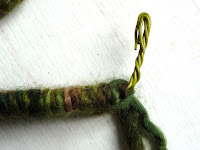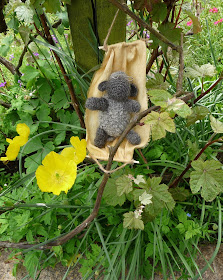Weaving this serpent took about 30g of pencil roving to be the weft and for the warp, two 1.8m lengths of thin, flexible, plastic coated garden wire. The wires were threaded through the holes in two weaving sticks and bent in half. The four ends of the wire were twisted together at the far end.
For the basic technique of making the sticks and weaving, see last week's blog. Before beginning, it helps to press the wire flat against the weaving sticks, so no bump stops the wool from being slipped down easily. Ask me how I know. Working from both ends of a centre pull ball, leave one tail about 10cm long and the other 50cm long, then begin weaving the pencil roving.
When there is only about 10cm of warp wires left uncovered, check you are happy that the weaving is evenly packed along its length and pull the weaving sticks through. Now, go back to the bottom end to finish the tail. Clip the loose wires beyond the twisted section, bend the twist over itself so that the sharp ends are rolled underneath, then bend it flat against the weaving. Using the short tail of wool as the lock, whip the wires
 against the weaving with the long tail. Here is a link showing how to do a whipped knot. Trim the loose ends of wool and go up to the top. At the head end, clip the wires where they pass through the weaving sticks and taking one wire from one side of the weaving and one from the other, twist the pair firmly together, clip this twist to about 2cm long, wind the loose end of the wool round it and bend the twist flat against the weaving to secure it, leaving the remaining two wires sticking out. A head piece for the serpent could be made from all manner of things. I tried a couple of prototypes, being best pleased with a roundish section cut from a small branch off the wood pile, sawed in half and painted with some green wood preserver I found at the bottom of a tin.
against the weaving with the long tail. Here is a link showing how to do a whipped knot. Trim the loose ends of wool and go up to the top. At the head end, clip the wires where they pass through the weaving sticks and taking one wire from one side of the weaving and one from the other, twist the pair firmly together, clip this twist to about 2cm long, wind the loose end of the wool round it and bend the twist flat against the weaving to secure it, leaving the remaining two wires sticking out. A head piece for the serpent could be made from all manner of things. I tried a couple of prototypes, being best pleased with a roundish section cut from a small branch off the wood pile, sawed in half and painted with some green wood preserver I found at the bottom of a tin.My companion was sitting in her usual observation post, on a shelf down the garage.
"Why are you cutting that firewood so small? O, Beaut, this is never more of those kits for that Crafts by the Sea shop? After last week's magnificent sales of one coaster kit, you just might be overloading the market."
"This serpent kit is going to be much more desirable. No more grey and white rug yarn, lush hand dyed roving will catch the shoppers' attention and the wooden head is going to be fab, with copper and brass eyes."
"Sea serpents are horrible things. They eat ships whole, Beaut, sailors, rigging and all." Elinor dunked a biscuit in her tea and chucked it down her gullet with grisly relish.
"Ugh, don't." I turned back to the work bench. "Bet serpents spit out the sheep. Like sour pips."
I drilled holes with a 2mm bit, one through the flat depth of the wood, to take a copper wire to bend round as part of the eyes, and one through the curve of the wood to pass the remaining pair of warp wires up. The centre of the eyes were brass upholstery studs hammered into the same hole. Actually, though the first one went smoothly, making another five heads for the kits was a complete nightmare of wire that wouldn't
bend and hammered fingers. I smiled through the pain rather than let Elinor hear me yelp. The weaving can be bent round the head and secured by twisting the last pair of wires at the neck. I undid mine again to add a frayed square of red chenille fabric as a sort of serpent's hood and then sewed on another piece for the tongue. Job done.




































